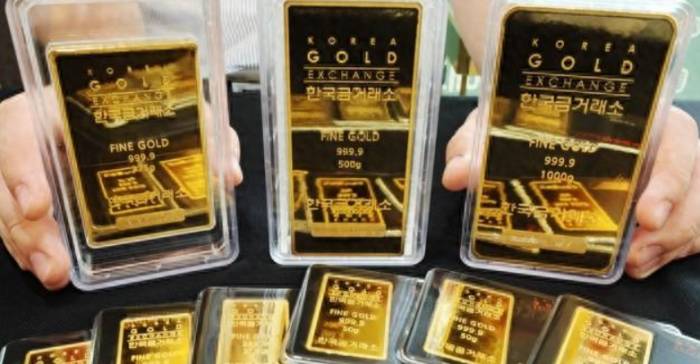Gold Nears $2700: Time to Buy?
On Wednesday, the international gold price set a new historical high for the fourth consecutive day. The main gold contract on the New York Commodity Exchange (COMEX) further approached the $2,700 mark, propelling the gold contract on the Shanghai Futures Exchange to break through the 600 yuan threshold for the first time. Amidst the widespread optimism from institutions, whether funds will choose to continue buying will be a point of interest.
Multiple favorable factors have driven gold prices to soar. So far this year, gold prices have surged by nearly 30%, making it one of the best-performing commodity futures. A new round of global central bank easing has ignited bullish sentiment, and since the Federal Reserve's rate cut last week, COMEX gold futures have risen by over 3%.
It is noteworthy that less than a week after the interest rate meeting, the pricing for another rate cut by the Federal Reserve in November has risen again. The Conference Board's consumer confidence index fell from 105 to 98 in September, marking the largest monthly drop since mid-2021. This indicates that a weak job market and high living costs are causing anxiety, once again sounding the alarm for the economy.
Jamie Cox, Managing Partner at Harris Financial Group, said in an email comment, "It's often a cause for concern to see such a significant drop in consumer confidence." He analyzed, "Consumers are clearly worried about the impact of the upcoming elections, as well as persistently high food and credit costs. When the Federal Reserve interprets the extent of the next rate cut, combining this data, a 50 basis point cut seems more appropriate."
Advertisement
According to the Chicago Mercantile Exchange's rate observation tool FedWatch, the possibility of the Federal Reserve cutting rates by another 50 basis points at its next policy meeting in November has risen from around 40% after the interest rate meeting to 57%.
At the same time, global central banks continue their gold purchasing pace. The World Gold Council (WGC) stated that the net purchase by central banks in July was 37 tons, a sequential increase of 206%, and the highest monthly increase since January of this year. Although prices are likely to have some impact on global central banks' demand for gold, the long-term net gold purchasing trend continues.
Geopolitical turmoil also supports gold prices, as there are concerns that the conflict between Israel and Lebanon may exacerbate the already tense situation in the Middle East. Roland Morris, a commodity strategist at VanEck, believes that now is the time to increase exposure to commodities. "China's stimulus plan, the Federal Reserve's rate cuts, and the decline of the dollar should be beneficial to all commodity sectors. In the long run, deglobalization, energy transition, and geopolitical conflicts are risks to commodity supply." He believes that the large and growing debt and deficits in Western countries are also expected to become significant factors supporting gold prices.
Gold ETFs are expected to become a new driving force. Fund flows indicate that a large number of Western investors are buying gold through exchange-traded products (ETPs) or exchange-traded funds (ETFs), and the gradual increase in holdings will also be reflected in market prices over time.The World Gold Council's statistics show that in August, global gold ETFs saw an inflow of 28.5 tons, equivalent to $2.1 billion. Among them, developed countries contributed the largest share, with North America increasing by 17.2 tons, accounting for an inflow of approximately $1.4 billion.
First Financial Daily reporters summarized and found that many institutions have recently expressed a bullish stance on gold until 2025. Standard Chartered Bank analyst Suki Cooper said: "Now that the interest rate cut cycle has begun, we believe that ETP inflows may accelerate, supporting the next round of gold price increases. ETP flows are usually more correlated with real yields and the US dollar. Most of the inflows come from Europe, but in the past two months, North American investors have shown new interest."

UBS released a report stating that although gold has repeatedly hit new highs this year and has outperformed major stock indices, it has greater room for operation in the next 6 to 12 months. "The key factors we believe include the recovery of substantial capital inflows into exchange-traded funds (ETFs), which have been missing since April 2022."
JPMorgan also believes that retail ETFs will be key to further sustained increases in gold prices, expecting gold prices to head towards the peak target of $2,850 by 2025. "In the past two years, strong physical demand from China and other central banks has supported gold prices, but retail-focused ETF positions continue to be key to gold's further sustained rebound in the upcoming interest rate cut cycle by the Federal Reserve."
The market is not short of cautious views. Saxo Bank's head of commodity strategy, Ole Hansen, said: "The current basis for new ETF demand is that interest rates are declining, but this leaves a question about whether investors are willing to buy at such high prices."
CITIC Construction Investment believes in its research report that the Federal Reserve's interest rate cut of 50 basis points in September is good for gold prices, but the market has already traded quite fully in the early stage, and the slowdown in the US economy and inflation behind the rate cut will suppress gold price space in the future. The current position is already overbought, and it is recommended to take profits at high levels in the short term.